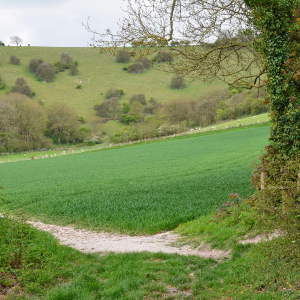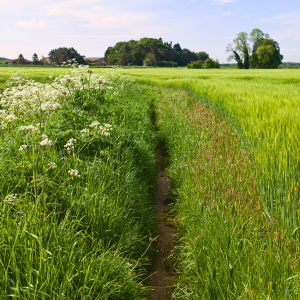Our Team are available on 01225 462871. You can also contact them by completing the form at the foot of this page. |
In an earlier article, we considered the ease or otherwise of removing a private right of way (an easement). Here, we consider the position of a public right of way through private land.
In many respects, a public right of way through private land is both a blessing and a curse for landowners. On the one hand, it encourages people to appreciate the countryside. But on the other, it can prove inconvenient (particularly if it crosses cultivated land) and costly to maintain.
What is a public right of way?
A public right of way is a highway (a linear route) over which the public can pass over land. Some rights of way have a statutory definition under Section 329, Highways Act 1980 and Section 192, Road Traffic Act 1988:
- Footpath: “a highway over which the public have a right of way on foot only“.
- Bridleway: “a way over which the public has a right of way on foot and a right of way on horseback or leading a horse, with or without a right to drive animals along the way“.
- Cycle track: “a way over which the public have the following, but no other, rights of way, that is to say, a right of way on pedal cycles…with or without a right of way on foot“.
Other less common rights of way include byways and restricted byways.
How is a public right of way through private land created?
Many public rights of way have existed for centuries. At a time when our major highways were little more than unsurfaced, potholed tracks, hundreds of thousands of well-worn paths crisscrossed the country. The local population used these when travelling to neighbouring villages, markets, or church. And drovers’ roads developed out of the need to drive livestock across the country to market.
While the way we use them has changed, many of the paths have not. Public rights of way are pretty unique to this country, although the ‘right to roam’ concept exists elsewhere.
Definitive map and statement
The definitive map and statement is a legal record of public rights of way held by a local authority, providing evidence of their existence and status. However, the Ramblers Association say they have identified 49,000 miles of rights of way not recorded on definitive maps.
Creating a new public right of way through private land
The creation of new public rights of way can be by:
- agreement with the local authority.
- order of a public authority – usually a local authority.
- a third party application based upon a presumed dedication.
 Presumed dedication arises after sufficiently long usage – generally for at least 20 years – without secrecy, force or the landowner’s permission. In this way, the test is the same as for a private right of way by prescription. But a path can be dedicated anytime, particularly if the landowner agrees.
Presumed dedication arises after sufficiently long usage – generally for at least 20 years – without secrecy, force or the landowner’s permission. In this way, the test is the same as for a private right of way by prescription. But a path can be dedicated anytime, particularly if the landowner agrees.
In addition, it’s possible to add previously unrecorded rights of way (ie historic ones). And the local authority can also amend the classification or route of an existing public right of way if evidence emerges that it’s wrongly classified, for example, from a footbath to a bridleway.
Extinguishing a public right of way
Public rights of way are rarely extinguished, so if a landowner wishes to divert or extinguish one, they face a considerable challenge. However, the local authority may be amenable to the landowner’s application if, for example, the existing route clearly interferes with agricultural operations and/or presents a public risk to health and safety.
Who is responsible for maintaining a public right of way?
Usually, the local highway authority is responsible for maintaining a public right of way. However, the landowner (or a predecessor) has sometimes assumed this responsibility, either expressly in writing or impliedly through repeated maintenance acts. But it’s important to remember that landowners are responsible for maintaining the land adjacent to the path to ensure its accessibility.
How to prevent a public right of way through private land
Landowners wishing to prevent a public right of way claim can mark their boundaries clearly and unambiguously with signs, fences, or other physical barriers. Preventing people from entering their land is the best way to avoid a claim. However, this can prove expensive and/or impractical, depending on the situation. And signage alone is often at the mercy of ‘proactive’ ramblers removing it.
 So, the most effective protection is afforded by Section 31(6), Highways Act 1980, setting up a presumption that no part of the landowner’s land is dedicated as a public right of way and protecting them from any public right of way claims for ten years.
So, the most effective protection is afforded by Section 31(6), Highways Act 1980, setting up a presumption that no part of the landowner’s land is dedicated as a public right of way and protecting them from any public right of way claims for ten years.
To do so, a landowner deposits a statement and plan with their local authority and pays a fee. The statement is the landowner’s declaration of ownership with the land outlined in an accompanying plan. They must acknowledge and annotate any existing public rights of way crossing the land. The declaration is a demonstration by the landowner of their lack of intention to dedicate any further public rights of way.
The landowner must then submit a statutory declaration confirming the position in their statement. After that, the landowner is responsible for submitting subsequent declarations, either confirming no changes or providing details of any changes.
It’s important to note that this procedure cannot defeat an application by presumed dedication if the twenty year period expired before the deposit of the statement and plan. Also, it cannot protect the landowner against evidence coming to light of a historic public right of way.
What is the right to roam?
The Countryside and Rights of Way Act 2000 granted public access to roam across certain upland areas and some common and uncultivated land in England and Wales. It covers land mapped as ‘open country’, principally mountain, moor, heath and downland. Since 2009, it has included areas of coastal margin. Currently, the right to roam exists over only 8% of land in England.
